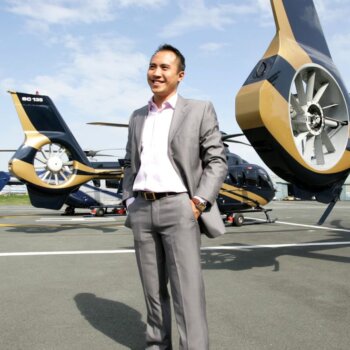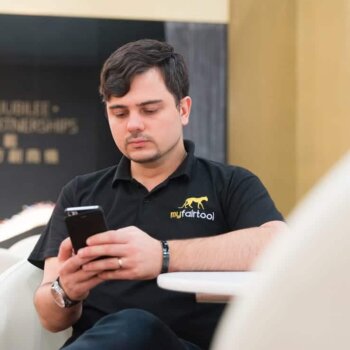(Women on Top in Tech is a series about Women Founders, CEOs, and Leaders in technology. It aims to amplify and bring to the fore diversity in leadership in technology.)
Maria Lasprilla is the Head of Core Product at Pipedrive, a sales management tool designed to help small sales teams manage intricate or lengthy sales processes. In 2016, Maria became one of the board members in Tech Sisters, an NGO whose main goal is to bring more diversity into the tech industry, particularly gender diversity. Although she is not a Board Member, she still continues to support the NGO as a volunteer – as Networking Events organizer.
What makes you do what you do?
I love working with people, and having a purpose together that we can achieve through tangible results makes me excited. Product management happened to me by chance, and it offered me that sweet combination that I had already experienced in my previous life as a teacher, where I helped people gain results in foreign language skills. I realized I couldn’t do a good job as a teacher if I didn’t care about the students. The same thing happens in product management. You have to care about the customer and about the team, to be able to deliver a valuable product that helps both the customer and the business.
The other important aspect for me is to be surrounded by people that are closely as excited as I am about trying new things, and that wasn’t happening to me in the teaching world, but it is another story in any industry where new technologies are at the center of the job. There are a lot of people in these industries exploring new ideas, tools and ways to work. That gets me going.
How did you rise in the industry you are in?
Crave for learning is in my blood. Being exposed to information technologies in my day-to-day life got me curious, and one thing took to another. I worked on a lot on side projects in my free time as a teacher. My friends and I had an NGO that needed a website being built and managed, so we could communicate our message to the world. I also tried to start a couple of businesses, and in all of them I ended up doing what a product manager did, except I didn’t have a name for it. I found problems, tested ideas on users, iterated on them until we got where we were all happy. Fast forward to 2018 and I am leading a small group of product managers to build a product for salespeople. I would not have imagined being here 10 years ago, but life happens, and it can be great.
Why did you take on this role/start this startup especially since this is perhaps a stretch or challenge for you (or viewed as one since you are not the usual leadership demographics)?
I needed a change in my life, and for changes to have a meaningful impact in your life, you have to stretch yourself beyond what you think you are capable of. Although I loved teaching, there were many ways in which I felt trapped. That was my motivation to move to another area.
Becoming a product manager was and continues to be a challenge not because I am a minority in a group where women are rare, but because I am always looking forward to going slightly beyond my capacity. When I took a job as a product manager at Pipedrive, I wasn’t biased by the view that there are few women in IT or that product management is a complex job. I was just focused on looking for something new where I could continue developing in an area I had discovered somewhat accidentally. The company did not see me as a rarity. They just wanted someone with energy, passion and a minimum of experience in the area, that was eager to help them solve problems, and I simply matched all of it. We were both meant for each other 🙂
Do you have a mentor that you look up to in your industries or did you look for one or how did that work? How did you make a match if you did, and how did you end up being mentored by him/her?
I have never had a mentor, but I always look for role models where I can. With the Internet, and particularly places like Twitter, Instagram, and Medium, it is really easy to get closer to the people doing work you admire, and that you can learn from, that otherwise would be really hard to reach because they are far from you geographically.
As a teacher, I used to connect with a lot of peers from around the world via Twitter that was constantly sharing what they were doing and learning, and I got through that what I couldn’t get in my direct community.
As I stepped into the IT world, one community that did it for me was the techsisters.org which luckily was based in Tallinn. There were people, like me, looking to make the leap from other areas (teaching, architecture, etc.) into information technologies. There were many in there that served as a role model in one way or another. To mention a couple: Kristel Kruustuk, co-founder of Testlio; all of the Tech Sisters co-founders, and a person unrelated to this NGO, Kristi Kuusk, an old friend that I worked with in an NGO, who is a designer-researcher working with smart textiles.
I have also resorted to books as mentors. “The Element: How Finding Your Passion Changes Everything” by Ken Robinson, and “The Freedom Writers Diary” by Erin Gruwell, were my main source of inspiration as a teacher. More recently, as a female leader and as a product manager, books like “Lean In: Women, Work, and the Will to Lead” by Sheryl Sandgerg, and “Radical Candor: Be a Kickass Boss Without Losing Your Humanity” have been doing it for me.
Online communities keep on playing an important role for me. Mind the product, Women in product, and the Silicon Valley are just but a few.
Now as a leader how do you spot, develop, keep, grow and support your talent?
As a growing leader in product management, there is a lot of uncertainty ahead of me but as I learn to be a good guide for my team, I have identified three key things to do so that I can help my team and myself move forward: one is keeping myself healthy and focused, another is to spend meaningful time with them, and the last thing, is to help create a culture around us of learning and self-initiative.
We are all young in our roles, and as a business, we are in our teen ages. This means that there is a lot that we don’t know, and I need to make sure my team and I accept and act on this fact, not to fear it, but to get us going in the direction of finding answers that will help us fill in these gaps.
Keeping myself healthy and focus is the foundation. I need to carefully identify the strengths and weaknesses in myself that will help me succeed or fail in this role, and I cannot do that if I am not mentally and physically strong. So I make sure every week that I decide a time to exercise and meditate.
The second important thing is to make the most of the time I spend with each of my team members, and intentionally create this space in my agenda to be available for them. I need to understand what are their aspirations, what do they have to offer for us to achieve our objectives as a team, and how aware or not are they of their own capacities so they can start working on them. I am not able to do this unless I give ourselves time to get to know each other.
At the same time, coaching and developing each person individually is not easy to afford, when there is a job that needs to get done under time pressure, so the third most important thing is to set up processes and tools that make it a norm for each of us to find answers among ourselves or outside the organization. Designing and defining these processes together is the most effective way to get them rolling. When they feel part of the process, they are more likely to carry forward, so I try to involve my team in every key decision where I know I will need them to be invested in.
Do you consciously or unconsciously support diversity and why?
I dare to say I am consciously and actively supporting an environment where everyone is welcome and considered capable. That being said, I should admit I am a victim of my own unconscious conceptions of the world. I can only interpret the world through my own experience, but that doesn’t make it right or wrong, it just makes it mine.
Learning to accept each other with our differences is something that requires effort and dedication. We generally grow up understanding that the right way to be or live is that which our parents, or community or practices as the right one, until we get out to the real world and discover that there are many more ways to live and understand the world, which is also OK, but just different from what we learned.
But there are obvious things that make me feel that I consciously do this: active participation in activities that introduce a world from a group to another. As a foreign language teacher, I introduce other cultures to my students, as a language is about understanding the world of others, not just about learning words. As a volunteer, promoting IT careers among young girls. In general, as a foreigner living in Estonia and choosing to learn their language and learn their world, I actively contribute to accepting and being part of the world by embracing all of its diversity.
The hardest question to answer is whether those who know me perceive that as well, or not. I can only hope they do.
What is your take on what it takes to be a great leader in your industry and as a general rule of thumb?
As a leader, people are your job. If you don’t dedicate time to care for, develop and challenge others, then you are not truly a leader. I am yet to discover what makes one “great” though 🙂
Advice for others?
Don’t let the fear of the unknown stop you from achieving great things. The difference between those that make a difference in the world (their world, others world, any world) and those that don’t, is that the former look at how they can best learn or overcome the challenges that are placed in front of them. They acknowledge the gap and then start finding ways to fill it in. Making a difference is also about making yourself a better self. The sole act of seeking to learn and understand already impacts our growth and this can on its own has a positive impact on others as well.
If you’d like to get in touch with Maria Lasprilla, please feel free to reach out to her on LinkedIn: https://www.linkedin.com/in/marialasprilla/
To learn more about Pipedrive, please click here.
To learn more about what Tech Sisters do, visit: http://techsisters.org/





























